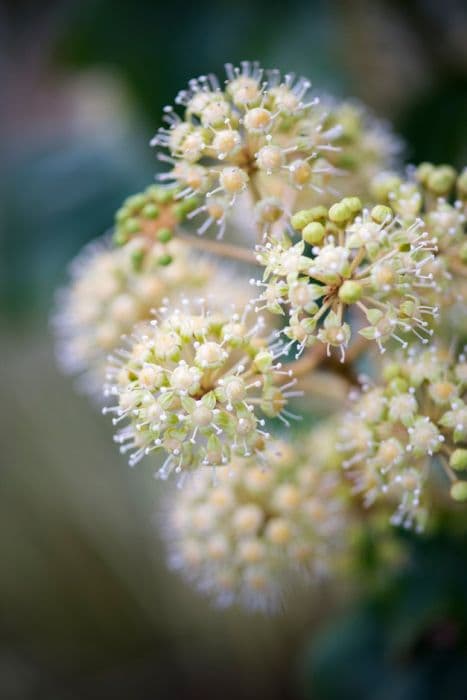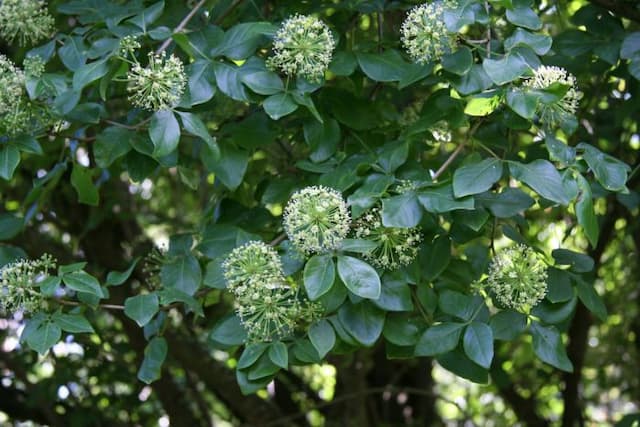Sun King Japanese Spikenard Aralia cordata 'Sun King'

ABOUT
The 'Sun King' is known for its striking golden-yellow foliage, which provides a bright, cheery presence in any garden. It boasts large, compound leaves that can add a tropical touch to the landscape. The leaves are made up of several small leaflets that are arranged in a pinnate fashion along a central stem, creating an elegant, feathery look. During the summer months, the 'Sun King' adds an extra splash of color with its small, white flower clusters. These flowers have a light, airy appearance and can attract beneficial insects to the garden. As the season progresses, these flowers may develop into small, dark berries that stand in contrast to the vibrant leaves. Overall, the 'Sun King' is a visually appealing plant with its luminous foliage and delicate floral displays.
About this plant
 Names
NamesSynonyms
Sun King Spikenard, Golden Japanese Spikenard, Mountain Asparagus.
Common names
Aralia cordata 'Sun King'.
 Toxicity
ToxicityTo humans
Sun King is not commonly listed as a toxic plant to humans. However, since specific reactions can vary, it is wise to avoid ingesting any part of the plant unless it is known to be safe or has been properly prepared for consumption, as some parts might cause stomach upset or other digestive issues if not properly identified and prepared.
To pets
The Sun King plant is not typically recognized as toxic to pets like cats and dogs. Nevertheless, pets should not be encouraged to eat ornamental plants as they could potentially cause mild stomach upset or an allergic reaction in certain sensitive individuals. If a pet consumes a significant amount of the plant and shows symptoms of distress, it is best to consult a veterinarian.
 Characteristics
CharacteristicsLife cycle
Perennials
Foliage type
Deciduous
Color of leaves
Gold
Flower color
White
Height
3 feet [91 cm]
Spread
3 feet [91 cm]
Plant type
Herb
Hardiness zones
4
Native area
Japan
Benefits
 General Benefits
General Benefits- Decorative Appeal: Aralia 'Sun King' adds a tropical look with its large, compound leaves that can brighten up shady areas.
- Shade Tolerance: It thrives in part to full shade conditions where many other colorful plants struggle.
- Easy to Grow: This plant is low-maintenance, making it a good choice for both novice and experienced gardeners.
- Drought Resistance: Once established, the 'Sun King' is somewhat drought-tolerant, reducing the need for frequent watering.
- Attracts Wildlife: The plant can attract pollinators like bees and butterflies, benefiting the garden ecosystem.
- Seasonal Interest: It offers visual interest with its bright golden foliage during spring and summer, with subtle changes in fall.
- Landscape Versatility: Can be used in a variety of garden settings, including borders, woodland gardens, and as a focal accent.
- Heat Tolerance: In addition to shade, it can also tolerate the heat, making it suitable for a wide range of climates.
 Medical Properties
Medical PropertiesThis plant is not used for medical purposes.
 Air-purifying Qualities
Air-purifying QualitiesThis plant is not specifically known for air purifying qualities.
 Other Uses
Other Uses- Aralia cordata 'Sun King' can be utilized in floral arrangements, particularly because of its large, brightly colored foliage that adds a tropical feel to bouquets.
- The plant can serve as a habitat for local wildlife, offering shelter and a potential site for nesting to small birds and beneficial insects in the garden.
- Its large leaves can be used as a natural mulch to suppress weeds and retain soil moisture when fallen and left on the ground in and around your garden beds.
- The dense foliage of Aralia cordata 'Sun King' can be a natural privacy screen for patios or outdoor seating areas.
- This plant's striking appearance is ideal for theme gardens, such as a "golden" or "sunshine" garden, focused on bright, vibrant colors.
- The plant can be used in educational settings to teach about plant care, propagation, and the importance of foliage plants in ecosystem diversity.
- Its stems can be harvested and used in artisan crafts for creating wreaths and other decorative items.
- When appropriately managed, 'Sun King' can be a backdrop for meditation gardens or other spaces designed for relaxation and contemplation.
- As a dynamic component of companion planting, Aralia cordata 'Sun King' can help create a microclimate for other shade-loving understory plants.
- The texture and color of the foliage can be inspirational for artists and designers, who might use it as a model for patterns or motifs in textiles and wallpaper.
Interesting Facts
 Feng Shui
Feng ShuiThe plant 'Sun King' is not used in Feng Shui practice.
 Zodiac Sign Compitability
Zodiac Sign CompitabilityThe plant 'Sun King' is not used in astrology practice.
 Plant Symbolism
Plant Symbolism- Resilience: Aralia cordata, known as the 'Sun King', is a hardy plant that can thrive in various conditions, symbolizing the ability to withstand and overcome adversity.
- Regal Presence: The 'Sun King' moniker conveys a sense of royalty and dignity, denoting leadership, influence, and a commanding presence.
- Illumination: Named after its bright golden foliage, it represents enlightenment, wisdom, and illumination in dark or challenging times.
- Growth: As the 'Sun King' can grow quite large, it symbolizes personal growth, expansion, and the reaching for greater heights in life.
 Water
WaterThe Sun King aralia should be watered when the top inch of soil feels dry to the touch, which may be approximately once a week, depending on the environmental conditions like temperature and humidity but always check the soil moisture level before watering. It's important to water the plant thoroughly until water runs through the drainage holes, ensuring that you saturate the entire root ball. On average, this might require about 1 gallon of water for large pots, although the exact amount can vary. Overwatering should be avoided, as it can lead to root rot, so ensure the pot allows for proper drainage, and never let the plant sit in standing water.
 Light
LightThe Sun King aralia prefers bright, indirect light to partial shade for optimal growth. It should be placed in a spot where it can receive dappled sunlight or near a north or east-facing window. Too much direct sunlight can scorch the leaves, whereas too little light can cause leggy growth and reduced foliage brightness.
 Temperature
TemperatureThe Sun King aralia thrives in a temperature range of about 60 to 80 degrees Fahrenheit. It should be protected from temperatures below 50 degrees Fahrenheit, as cold drafts and sudden temperature drops can damage the plant. The ideal growing condition is within the warmer end of this range, making it a great indoor plant for standard home temperature settings.
 Pruning
PruningPruning the Sun King aralia is generally done to maintain shape, control size, and remove any dead or damaged foliage. It is best to prune in the late winter or early spring before new growth begins. The pruning frequency is based on personal preference and the desired appearance of the plant; light annual pruning is typically sufficient.
 Cleaning
CleaningAs needed
 Soil
SoilThe Sun King prefers a well-draining, humus-rich soil mix with a pH range of 6.0 to 7.5. A blend of two parts garden soil, one part peat or compost, and one part perlite or sand facilitates the right environment for its growth.
 Repotting
RepottingSun King Aralia should be repotted every 2 to 3 years, or when it becomes root-bound and its growth appears to be stunted.
 Humidity & Misting
Humidity & MistingSun King Aralia thrives best in moderate to high humidity levels, typically around 60-80%. It benefits from misting if the indoor air is dry.
 Suitable locations
Suitable locationsIndoor
Place in bright, indirect light and maintain high humidity.
Outdoor
Grow in partial shade, shelter from strong winds.
Hardiness zone
4-9 USDA
 Life cycle
Life cycle'Sun King' Spikenard (Aralia cordata 'Sun King') starts its life cycle as a seed, which upon germination in early spring, develops into a small seedling. As it matures, the seedling grows into a large herbaceous perennial, featuring bright golden-yellow leaves if exposed to a few hours of sun, though it can tolerate shade where the foliage may turn more lime green. During the summer months, it produces small white flowers that are arranged in large panicles, attracting pollinators such as bees and butterflies. Following pollination, these flowers can develop into purple-black, inedible berries by fall, which are often sought after by birds. Towards the start of winter, the plant's above-ground foliage dies back, with the root system remaining dormant underground. In the following spring, the cycle resumes as the plant regrows from the roots, continuing this process for many years, typically experiencing a lifespan of about 20 years under optimal conditions.
 Propogation
PropogationPropogation time
Spring to Early Summer
The most popular method for propagating 'Sun King' Spikenard, scientifically known as Aralia cordata 'Sun King', is through division. This is typically done in the spring when the perennial plant wakes from dormancy and begins to show new growth. To propagate by division, carefully dig up an established clump of the plant and separate it into smaller sections. Each section should have a portion of the root system and several shoots. Once separated, these divisions can be replanted in well-prepared garden soil, ensuring that they are watered thoroughly to help establish the new plants. This method is relatively straightforward and maintains the genetic consistency of the 'Sun King' Spikenard since the offspring are clones of the parent plant.









